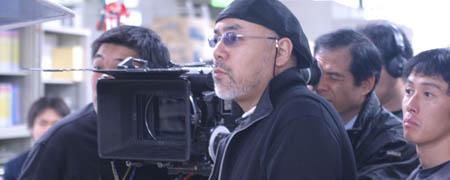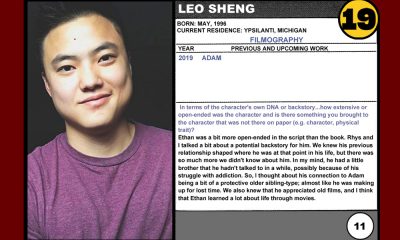Retro IONCINEMA.com
Int: Akira Ogata
In a certain town of hills, Ohba Minako (Tanaka Yuko) begins her day running up and down its steep slopes delivering milk, after which she goes to her job as a supermarket cashier. She is 50, single. In one of the houses to which she delivers milk lives a man with whom she has secretly been in love since high school. That man, Takanashi Keita (Kishibe Ittoku) lives with his wife Yoko (Nishina Akiko), who is terminally ill. Caring for her at home, he works in the Children’s Affairs Section of the local municipal office. Insisting that he wants nothing more than an ‘ordinary’ existence, his life is one of constant turmoil. Amid all of this his thoughts, too, are on Minako. Eventually great change comes to their ‘ordinary’ lives. The loves of Minako and Keita, and those of the people living around them, rise and fall with the hills of the town.
Born 1959 in Saga Prefecture, Akira Ogata began making 8mm films in high school. With the intention of becoming a filmmaker dropped out of Fukuoka University to come to Tokyo after meeting director Ishii Sogo. After being an assistant to Ishii, he became a freelance director in 1986 and has directed more than a hundred music videos and TV dramas since then. Akira Ogata made his big-screen debut with Boy’s Choir in 2000 and won the Albert Bauer Prize for the best new director in competition at the Berlin Film Festival as well as many other prizes. Since 2002 he has been a lecturer in film at the Japan Academy of Moving Images and the Kanto Gakuin University.
In 2004 he completed his second full-length feature, The Milkwoman (Itsuka Dokusho Suruhi). He was in town to introduce the film to journalists and cinephiles at the Montreal World Film Festival and during the fest’s last day, Ioncinema sat down with Japanese movie director Ogata Akira for an interview about his latest film. The interview was held in French/Japanese with Japanese/French translation by Dr. Minoru Tsunoda.

Pierre-Alexandre Despatis: What has been the reaction to this film in your native Japan?
Akira Ogata: I am very happy. In Japan since the movie started to be screened in theaters in September, there are many Japanese women older that 50y/o who go see the film. In general, older people don’t go to the theaters, so I’m very pleased. I’m also very pleased that most reviews of the film in Japan are very positive. I hope I can win a prize with this film at the end of the year [laugh].
PA-D: This is your second feature film. Can you compare your approaches to the shooting of both films?
AO: In relation to the first film, in terms of the production costs and the number of crew members it tripled. However, it meant that I had much more pressure.
PA-D: Was this pressure a healthy one, or did it just make things more complicated?
AO: [laugh] When you have a lot of experienced crew members and collaborators on a project with you, they will often provide their own suggestions and ideas. On large scale projects such as this one, it can be difficult to coordinate these good ideas. On the other side, for the first film, I was a director who was starting his film career. Many actors were also at the start of their career too. So, since it was an independent film, we lived together, we shared everything. For this film we had hotels, drivers and so on; so our lives were much easier during the shooting.

PA-D: Could you tell us about the shooting of the film in Nagasaki ?
AO: Most of the film takes place when the milkwoman is delivering the milk, which means very early in the morning. The shooting took 5 weeks and during those 5 weeks, I had the whole crew wake up at 3AM on 22 consecutive days to start shooting as early as possible in the day. If you’re a cameraman you know it’s very difficult to shoot at that time. The light is constantly changing; every 20 seconds it is practically different! As I said, I wanted to shoot in Nagasaki even though the city in the film was an ordinary and unnamed city. My idea was to use the city as a studio. Many elements including the street names and the bus stops have been hidden to make the city anonymous. The set design was very difficult for that reason.
PA-D: This film also marks you second collaboration with screenwriter Aoki Kenji who also wrote your first film “Boys Choir”. Could you talk about your relationship with this person.
AO: It’s like a relationship between John Lennon and John McCartney or between the Coen brothers. In Japan, we are often called the John Lennon and John McCartney of Japan. So, Aoki Kenji prepares a script and we work together on making the project come to life. Mr. Aoki is very timid. He was also invited to the festival but he preferred not to come. He’s out of the ordinary and idiosyncratic.
PA-D: What’s next for you two? And what is your next project?
AO: There is nothing concrete. As a director, I watch many films. I often say to myself that I’d like to do a film similar to this or that film I saw. However, what I know is that I’d like to have less dialogs in my next film. I’m also looking forward to make an entertainment film at some point.
PA-D: The film takes place in an anonymous city but was shot in Nagasaki. The story could practically happen everywhere.
AO: Yes. This is a very important question I had in mind when doing the film. The writer wanted to make the film about a typical town in the neighborhood of Tokyo. He originally wanted to use a simple and ordinary city. However, as soon as I read the script I wanted to shoot in Nagasaki. The story has many literary characteristics but I wanted to add more physical elements with the steps. I asked the permission to the screenwriter and the producer to shoot there. The screenwriter accepted but at two conditions. First he didn’t want me to include the sea in any shots, even though Nagasaki is literally surrounded by sea. Also, he wanted me to exclude from the film any elements that could permit to identify the city, such as street names. The reason was obviously because when people think about Nagasaki they make an automatic connection to the A-Bomb.
PA-D: The profession of the Milkman seems to be a dying one – something which you underline when the customer wants to buy a cartoon of milk at the supermarket. Is the milk distribution still prevailing in Japan, or is it a tradition that disappears slowly.
AO: Since the 70s or so, the importance of the milk distribution was in constant diminution. However, in the past few years it started to be more popular because in certain towns. In towns like Nagasaki for example, there is an increasing number of elderly people who can’t use the steep steps to buy milk or go to the grocery store. So in the past few years this industry became more important.
PA-D: Like a newspaper delivery boy, a milkman or milkwoman is a person that goes unnoticed. Yet they both are very important.
AO: There is a big distinction between the distribution of the milk and the distribution of newspapers. For newspapers, we talk about events or incident that happens in the public realm. As for milk distribution, they distribute nutrition; they distribute life. Unlike a newspaper delivery boy, the milkwoman distributes milk, a very nutritive element that gives life. I found this analogy interesting. I asked to Aoki Kenji why he chose milk distribution rather than newspaper distribution. He said that in the case of newspaper distribution, there was only a copy given per home, regardless of the amount of people living at that address. However, with milk, if there are 3 people living in the home, 3 bottles will be distributed. This is a major difference. If there is one less person, there will be one less bottle distributed. By delivering milk, we can thus understand what is going on in every home. It’s a communication between the inhabitants of the village and the milkmen. It can be seen as a bilateral mode of communication in a way.

PA-D: With this mode of communication, the milkwoman can ‘listen’ to others but she doesn’t seem to listen to her own sentiments. None of the characters except the dying woman express their true feeling, nor do they listen to their sentiments. Where does the inhibition of the characters come from.
AO: In Japanese history, people weren’t always able to express themselves. Now, young people express themselves a lot more in making many friends and new connections. This is a very occidental way of living. I wanted to reflect about original Japanese lifestyle in the film.
PA-D: Speaking about connections, there is a very unlikely relationship between the dying woman and the milkwoman. The dying woman even notices that the milkwoman is a few minutes late one morning. What is the importance of this shot in the film ?
AO: Everybody has a routine in his daily life. The same applies for the milkwoman in the film. When there is an change in a routine, even a very subtle one, it often means that there was a change in the person’s life. This is what I wanted to describe with this shot. Something was different in the milkwoman from that day on. The change in her routine is very subtle; she is only a few minutes late, however the dying woman was very sensitive to this.
PA-D: Yet, the dying woman is the only person who can’t drink milk.
AO: Yes. For her husband, it was a pleasure to see his secret lover come at his home every morning. However, as the dying woman wasn’t able to drink milk anymore due to her sickness, the man wanted to stop the milk distribution. The wife said no. This is from that point on that she accepts the relationship between the milkwoman and her husband.
PA-D: The Milkwoman and the film Nobody Knows by director Hirokazu Koreeda both discuss child neglect. Is child abuse frequent in Japan ? Also, could you talk to me more about the child in the film; unlike the other characters, he doesn’t have any direct connection with the milkwoman.
AO: Unfortunately, child abuse is very frequent in our society. There are many news reports about neglected children. In some cases the child dies because he wasn’t given enough food. In other cases, when parents go to entertainment centers they leave their in the car and in some cases they might die. There are many such incidents in Japan. In the past few years, many Japanese cities created institutions to prevent child abuse, as we can see in the film.
As for the importance of the little boy in the film, it’s true that he doesn’t have any connection to the milkwoman. However, I wanted to describe people in general. There is a dying woman, a milkwoman, the child and so on. Although the film is mainly about the milkwoman, I wanted to portray other people that lived in the city.
PA-D: Your sense of pacing is perhaps the film’s strongest point. Could you tell us how you approached the editing of the film in relation to the overall pacing ?
AO: It’s usually very easy to estimate the length of the film just by looking at the number of pages. Before the shooting started, I estimated the film would last about 110 minutes. While making the film and giving directions to the actors the film became a bit longer. I discussed it with the producer and the rest of the crew and they agreed to keep the length of the film even though the film was planned to be shorter.
Also, something very important is “time spacing”. If we only followed the script, the film could have been very short. But, we wanted to add temporal spaces in the film. The film became longer but those spaces were necessary to create the proper ambiance and atmosphere for each scene.
PA-D: The atmosphere of the film is quite interesting. Throughout the film, the spectators are torn between feeling of sadness and feelings of hope and joy. On this regard, one of the last shot of the film where we sees the village from Ohba’s point of view really envelopes how the protagonist feels about her purpose in life. How did that shot come about?
AO: For the first time I included a shot of the sky. So, with that shot I wanted to create the feeling that not only the milkwoman decided to live in that city but that she decided to confronts it and all the things she decided to ignore or overlook during the film. I don’t think this film is a tragic film even though it is very sad. By adding that shot which wasn’t in the original script, I added a little hope in the film.
When someone we know dies, it’s not the end of the world. We must continue to live with hopes or with some difficulties in some cases. Life is a succession of small experiences and we must all live with that. Of course, when the milkwoman lost her lover it was very difficult for her. However, the shot on the hill is rather a moment of joy. She has accepted his death and that shot signifies she is able to move on.
PA-D: True; even though the end is rather tragic and most of the film is very sad, there is a certain joy and serenity that seems to emanate throughout the film especially towards the end. At the end of the film even, the main character has a big smile on his face; the smile even puzzles experts as the narrator says.
AO: I’m a director and I’ve seen many films. I always try to identify what emotions I feel when watching the film. Also I like to take into account all the elements and the emotions that come directly from the film, in opposition to the emotions that came from my mind. This is a bilateral communication between the film and me. The films I like are films where this relation can be exploited by the spectator. So, I built this film in such a way to allow this bilateral communication to happen. This often can lead to many self-discoveries.

Pic taken during press conference held earlier.
PA-D: The way you talk about the film is very philosophical. The film is too; there seems to be many underlying metaphors in the film. For instance, very few things are explicitly shown on the screen and we have to imagine everything. For example, we don’t see the child being abused. Neither do we see the tragic events at the end of the film.
AO: There are sex scenes and very explicit violence in many movies. It’s not my objective to include those in my films. My goal in making movies is to show what is invisible. For example, I don’t want to show sex scenes explicitly. Rather, I want to show such scenes in such a way that spectators can imagine themselves what is happening. It’s the same thing with violence; I don’t want to show it directly, it’s the spectators who have to infer it.
This is different than what certain other Japanese directors do. I’m thinking for example about Miike Takashi (Audition, Ozu, …). His approach to the medium is totally different. He shows some very graphic scenes in his films, some that other directors wouldn’t even dare to show. He goes directly to the point. In my case, I prefer to take an indirect approach because it leaves much more work to the spectator as they have to infer everything.
PA-D: There are also many editing tricks in the film or pieces of dialog that have a lot of undertone. There are a lot of subtle associations in the film. This is very similar to Mikio Naruse. Was this connection to Naruse intended.
AO: You know, as directors we take many elements in consideration when making our films—including our own experiences. This is what I did in this film. I lost my father and I got married. Those elements are in the film. Naruse is one of my favorite directors. Maybe without planning it, there is probably something about him in The Milkwoman. The only direct reference I made to a director is Robert Altman.
PA-D: And it is … ?
AO: [laugh] This is something That has to do with me and me only. If I’m the only one to see it that enough for it to exist.
The Milkwoman will continue screening on the festival circuit.
Pictures 1 and 4 courtesy of Pierre-Alexandre Despatis. (c) 2005.



























